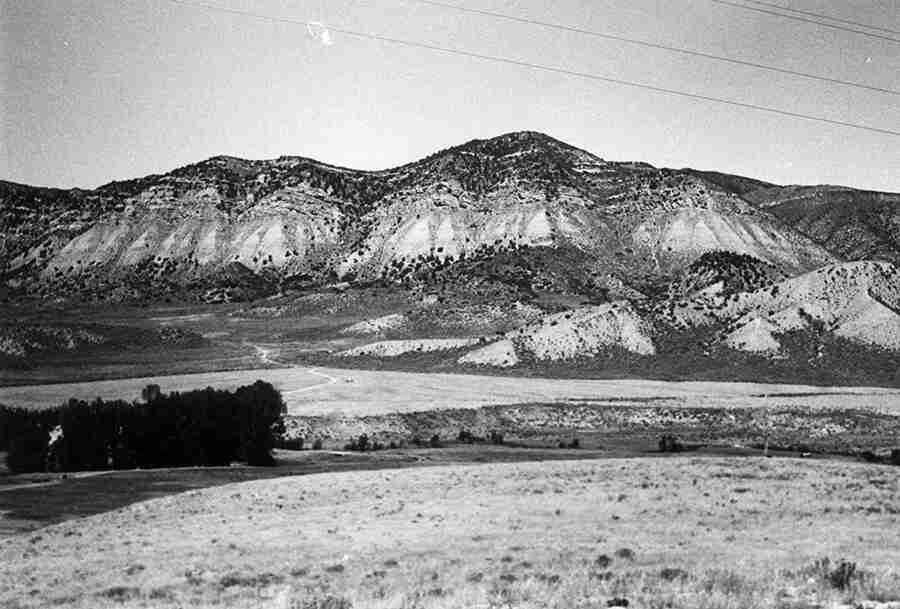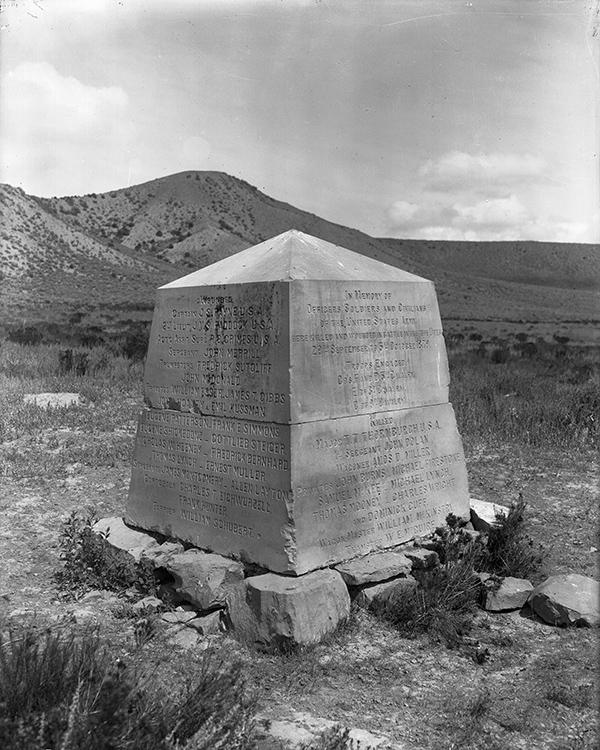Battle of Milk Creek
Full Article
The Battle of Milk Creek was the major military engagement during the Meeker Incident, a revolt by a Nuche (Ute people) community in northwest Colorado in September 1879. The battle began on September 29, when Utes opened fire from the heights above Milk Creek on an advancing column of US cavalry led by Major Thomas Thornburgh. Utes kept the soldiers pinned down for five days, until reinforcements arrived and the Utes surrendered on October 5.
The battle delayed Thornburgh’s advance to the White River Ute Indian Agency, where Indian Agent Nathan Meeker had called for assistance because of rising tensions with the local Ute population. While the Utes at Milk Creek held up Thornburgh, Utes at the agency revolted, killing Meeker and ten others and taking his family captive. In the long term, the violence was brought on by Meeker’s harsh treatment of the Utes; in the short term, it was a result of Thornburgh’s decision to advance onto the Ute reservation, which the Utes took as an act of war in violation of the Treaty of 1868.
Origins
By the 1860s, Colorado’s Ute people had lived in the Rocky Mountains for more than 400 years. In 1868 leaders representing six bands of Colorado’s Ute people signed a treaty that ceded Colorado’s eastern Rockies to the United States in exchange for annuities and the creation of a permanent reservation on the Western Slope.
In the far northern part of the reservation, on the White River near present-day Meeker, the US government set up one of two Indian Agencies to distribute food and supplies as promised in the treaty. Throughout the 1870s, Utes at the White River Agency became increasingly hungry and anxious. Shipments of food and supplies were delayed or not delivered at all, and Utes often left the reservation to hunt and to take supplies from white settlements.
In 1878 President Rutherford B. Hayes appointed Nathan Meeker, a cofounder of the Union Colony at present-day Greeley, as head of the White River Agency. A devout and ambitious man, Meeker was seen as the perfect agent to carry out the government’s policy of assimilating, or “civilizing,” the Utes of western Colorado. Upon his arrival at the agency in early 1879, Meeker moved its buildings onto a Ute horse pasture, the beginning of a poor relationship with his charges that would only get worse in the ensuing months.
As the Utes continued to resist farming and leave the reservation to hunt, Meeker’s patience wore thin, and at one point he even withheld rations from the Utes as punishment for their refusal to follow his teachings. He kept plowing the Utes’ horse pastures, determined to sever their centuries-long bond with the animals. Where other agents might have taken a more lenient approach toward the Utes in exchange for cooperation, Meeker would accept nothing but total compliance.
Meeker’s stance began to wear on local Ute leaders Johnson and Douglass. After Meeker arrived, both were initially willing to try a bit of farming, but as the agent’s conduct toward them worsened, they grew increasingly agitated, to the point of shouting matches. During one argument late in the summer of 1879, Johnson shoved Meeker and hurt the agent’s arm. Fearing for his life, Meeker requested federal troops to come to the agency to protect him.
Thornburgh’s March
Stationed at Fort Fred Steele in Rawlins, Wyoming, Major Thomas Thornburgh had little idea of the tensions building at the White River Agency in the summer of 1879. In mid-September, he was about to leave for a hunt when he received urgent orders from his superior, General George Crook, to ride to Meeker’s assistance some 200 miles away. It took Thornburgh five days to get his cavalry ready, and on September 21 his column of 191 officers, soldiers, and civilians, with its 370 mules and horses, left Rawlins for the White River Agency.
On September 26, Thornburgh happened upon Jack, a White River Ute leader, at a general store near the Yampa River in northwest Colorado. The clerk told Thornburgh that Utes had recently purchased 10,000 rounds, and Jack asked Thornburgh about his destination. When Thornburgh told him that Meeker had asked for help with Utes at the agency, Jack replied that Meeker had brought the trouble on himself, and that if Thornburgh entered the reservation, it would be taken as an act of war.
The next day, Thornburgh got word from Meeker: the Utes at the agency knew of his advance and asked him to stop his column at some point outside the reservation and proceed to the agency himself, with only five soldiers. All parties would then discuss a resolution. Thornburgh responded affirmatively, writing the agent that he would make camp at Milk Creek, a tributary of the White River near the boundary of the reservation, and proceed from there with a handful of soldiers.
Battle Lines
After another Ute leader, Colorow, visited his camp to ask where he was going, Thornburgh was alarmed. But he knew he outnumbered the Utes and doubted they would actually fight him. Instead of heeding the Utes’ warning, Thornburgh deferred to his orders from Crook, who had told him to proceed through the reservation to the agency. Thornburgh and his officers believed that leaving their full force beyond reach of the agency was too risky, so they devised a cautious plan to invade the reservation.
The Utes, meanwhile, feared Thornburgh’s advance might signal another Sand Creek Massacre in which peaceful Indigenous people were promised safety only to be cut down by federal troops. Led by Jack and Colorow, several dozen Utes waited behind rocky outcroppings on the heights above Milk Creek, armed with rifles. About fifty more waited with their mounts below, just off the main wagon road that led to the agency. If the soldiers crossed the creek, in violation of the 1868 treaty, the Utes would fight.
Five Days of Fighting
At the agency on the morning of September 29, Meeker assured Douglass that Thornburgh would not enter the reservation. But Thornburgh had already made his decision. The major crossed dry Milk Creek with all his troops, leaving behind only his cumbersome wagons. The lead unit promptly ran into Jack’s Utes, and even though both sides signaled that they wanted to talk, a shot was fired—it is not known by whom—and the battle began.
The Utes rained gunfire down from the heights, inflicting immediate casualties. They targeted the soldiers’ horses to prevent the cavalry from quickly regrouping or retreating. Meanwhile, Thornburgh took a sharpshooter’s bullet to the head and died instantly. Back at the agency, Utes got wind of the battle and decided that Meeker had misled them for the last time. The Utes killed him and his entire staff and captured their wives and children.
Meanwhile, the dismounted cavalry retreated to the other side of Milk Creek, hunkering down behind the wagons and taking fire from the front and both sides. The troops used dead horses and mules for additional cover, returning fire as the Utes moved closer. Unable to retreat that night, Captain J. Scott Payne, the ranking officer after Thornburgh’s death, hastily sent messengers for reinforcements. Word reached both Captain Francis Dodge, commander of the Ninth Cavalry near Steamboat Springs, and Colonel Wesley Merritt in Rawlins.
On October 1, after a seventy-mile forced march, Dodge’s three dozen Buffalo Soldiers arrived to help Payne’s besieged troops. While unable to turn the tide, the Ninth Cavalry forced the Utes to cease their barrage and regroup. Ultimately, the Buffalo Soldiers extended the battle by four days, enough time for Merritt’s 450 men to arrive from Wyoming. When they finally did, on October 5, the Utes retreated. In the six-day battle, seventeen whites were killed and forty-four were wounded. About two dozen Utes were killed, most on the first day of fighting.
The soldiers marched to the agency, where they found burned buildings and the mutilated bodies of Meeker and his staff. A party of Utes had carried the women and children, including Meeker’s wife and daughter, off toward Grand Mesa.
Aftermath
Word spread quickly of the battle and Meeker’s death. Led by Governor Fred Pitkin, Colorado’s press and white officials called for the Utes’ removal or extermination. The state legislature passed a Ute removal declaration. Outside the state, however, newspapers blamed Colorado miners for coveting Ute land as well as the federal government for not supplying the Utes with the provisions and money promised in the treaty.
Meanwhile, the US Army mobilized to hunt down the Utes who took Meeker’s family captive. With the help of other Utes, government agents negotiated the peaceful release of Meeker’s family and the rest of the captives in late October.
Two separate investigations into the Meeker Incident—one at the Los Piños Indian Agency in 1879 and congressional hearings the next year—failed to identify or punish the Utes who killed Meeker. The Battle of Milk Creek was considered a legitimate engagement—the army had trespassed on the reservation—so Jack, Colorow, and the other Utes who fought in the battle were not punished.
Legacy
The Utes’ victory at Milk Creek was short-lived, as it soon led to their expulsion from Colorado. Although only the Parianuche and Yampa Utes participated in the Meeker Incident, Ouray’s more numerous Tabeguache band was implicated by association, in part because the government considered Ouray the de facto leader of all Ute bands. Ouray and Interior Secretary Carl Schurz lobbied to keep the peace on both sides, and their efforts avoided further bloodshed. In 1880, however, the government forced the Yampa and Parianuche, as well as Ouray’s Tabeguache, to give up all their land in western Colorado and move to a new reservation in Utah.
The Battle of Milk Creek and the Meeker Incident showed that the government strategy of assimilating Indigenous people was deeply misguided. Not only had the Utes resisted farming, but attempts to force them into it had provoked the very sort of violence—from both sides—that government agents and Christian reformers sought to avoid.
White observers, however, ignored this lesson and simply assumed that Colorado’s Utes were “bad Indians” who acted against their own interests by resisting “civilization.” Indeed, over the next several decades, the government continued its policy of forced assimilation by breaking up Indigenous reservations into private allotments and banning traditional customs and ceremonies. Just as they did at Milk Creek, these policies provoked outrage and violence, such as when US cavalry massacred Lakota at Wounded Knee in 1890.
Commemoration
In 1990 the Rio Blanco County Historical Society established Milk Creek Battlefield Park on the site of the battle. Informative signs detail the events of late September 1879, and a stone monument memorializes Thornburgh and the other soldiers who died there. Thornburgh’s body was eventually recovered from Milk Creek and is buried in Omaha, Nebraska. In 1993 the Rio Blanco Historical Society and Ute Indian Tribe agreed to have tribal members erect a monument to the fallen Ute warriors next to the US Army monument.













